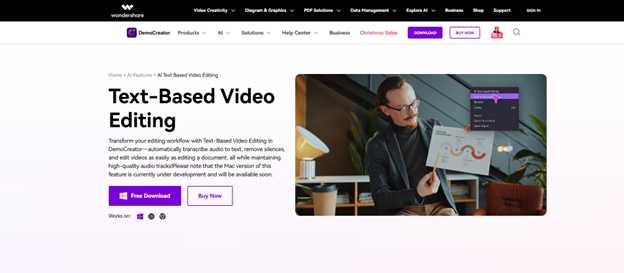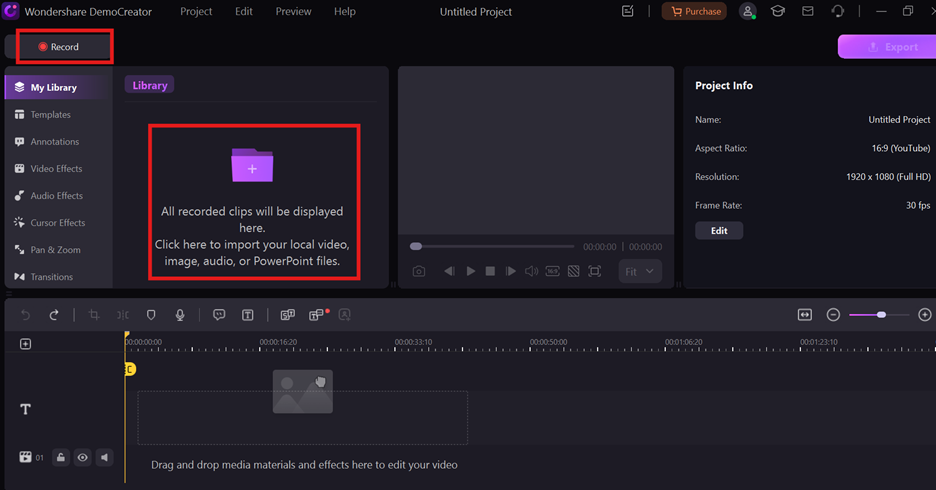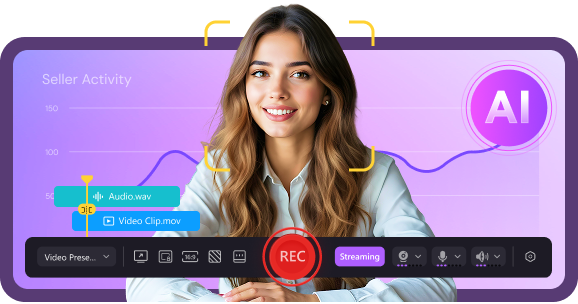Voice-to-text technology has transformed transcription by offering seamless solutions for converting spoken words into written text. These audio-to-text conversion applications have become essential tools for professionals, educators, and content creators, helping them save time and enhance productivity. With advancements in technology, talk into text apps, and other cutting-edge voice to text applications are delivering unmatched convenience and accuracy.
In 2024, the range of options continues to grow, with many standout choices available. From intuitive voice into text apps to feature-rich audio to text converter apps and apps that transcribe audio into text, these tools cater to diverse needs. This article explores the top talk to text apps, highlighting their unique features, key benefits, and ideal use cases to help users find the perfect solution for their transcription needs.
In this article
Part 1: Brief Overview of Voice-to-Text Application

Voice-to-text technology has transformed how we capture and process information by enabling the seamless conversion of spoken words into written text. This innovative solution has become indispensable across various fields, including business, education, and content creation, where transcription enhances productivity, accessibility, and communication. Businesses use it for documenting meetings, educators rely on it for lecture notes, and content creators repurpose transcriptions for blogs and subtitles.
With the growing demand for accurate and efficient transcription, choosing the right audio-to-text conversion applications is critical. This article highlights the top voice-to-text tools of 2024, showcasing advanced features that simplify transcription and cater to diverse user needs, empowering individuals and organizations alike.
Part 2: What to Look for in a Voice-to-Text Application
Selecting the best voice to text application involves evaluating key factors that ensure seamless transcription and optimal user experience. From accuracy to pricing, these features determine how well the application meets your needs, whether for casual use or professional workflows.
- Accuracy
The foundation of a good voice-to-text tool is its transcription accuracy. Reliable applications excel in understanding diverse accents, dialects, and speech patterns, even in noisy environments. High accuracy ensures minimal manual corrections, saving both time and effort. - Ease of Use
A user-friendly interface is essential for accessibility and efficiency. Look for applications with intuitive controls, clear navigation, and straightforward commands. Easy-to-use tools ensure that users of all skill levels can achieve effective results with minimal learning curves. - Features
Modern audio to text converter apps offer more than basic transcription. Additional functionalities like real-time editing, multi-language support, and formatting tools significantly enhance productivity. Features such as punctuation commands and integration with other applications add value for diverse use cases. - Compatibility
Device and platform compatibility are critical for seamless workflows. Ensure the application works across your preferred devices, including mobile and desktop platforms. Web-based tools and cross-platform support offer greater flexibility for users on the go. - Pricing
Consider whether a free tool meets your requirements or if a paid version offers better value. Paid tools often provide advanced features like higher transcription accuracy, multi-language support, and robust editing tools, making them worth the investment for professional use.
Part 3: Top 10 Voice-to-Text Applications for Accurate Transcription in 2024
Voice-to-text applications have become essential for transcription tasks, catering to a wide range of needs. From students taking notes to professionals transcribing interviews, these tools streamline workflows with advanced features and accessibility. Here are the top voice to text applications to consider in 2024 for accurate and effortless transcription.
1. Wondershare DemoCreator
Wondershare DemoCreator is a comprehensive voice-to-text tool that combines transcription and video editing capabilities. It uses AI to provide accurate and seamless transcription for audio and video files, making it a go-to for content creators and educators. With features like multi-language support and silence detection, it caters to both professional and casual users. Its user-friendly interface ensures accessibility for beginners and advanced users alike.

Key Features
- AI Transcription: Converts video and audio into text effortlessly.
- Integrated Editing Tools: Allows simultaneous transcription and video editing.
- Multi-Language Support: Handles transcription in various languages.
- Silence Detection: Automatically removes pauses in audio.
- Export Options: Supports exporting in TXT, DOCX, and SRT formats.
Platforms: Windows, Mac
Best Use Cases: Creating audiobooks, video narration, and marketing content.
Steps to Convert Videos into Text Using Wondershare DemoCreator
Step1Import Your Video for Text Conversion
Open Wondershare DemoCreator and create a new project. Click the "+" button to upload your video file, setting the stage for accurate transcription and editing. This simple process ensures your video is ready for processing.

Step2Generate AI-Powered Text Transcripts
Drag your video to the timeline and access the "AI Text-based Editing" feature. Choose your language, and the tool will generate a precise, synchronized transcript, making it easy to refine the text alongside your video.


Step3Refine Transcripts and Remove Pauses
Edit the transcript to ensure accuracy and use the Silence Detection feature to eliminate unnecessary pauses. This step polishes the content, ensuring a seamless and professional final video.

Step4Finalize and Export Your Video
Customize your video by enhancing text styles, colors, and animations. Once the edits are complete, export the project in your preferred format or upload it directly to platforms like YouTube.

2. Notta
Notta is a cloud-based transcription solution designed for real-time and batch transcription needs. It excels in handling multi-language inputs, making it a versatile option for business meetings, lectures, and team collaboration. Its integration across platforms ensures flexibility for users on the go. Notta’s ability to share and edit transcripts makes it ideal for professionals working in teams or individuals managing multiple projects.

Key Features
- Real-Time Transcription: Converts speech into text as it’s spoken.
- Collaboration Tools: Share and edit transcripts with your team.
- Multi-Language Support: Recognizes over 100 languages.
- Cloud Syncing: Access transcripts across devices.
- Batch Processing: Process multiple files simultaneously.
Platforms: Web browser, iOS, Android, Chrome Extension
Best Use Cases: Meeting notes, lectures, and content creation.
How to Use Notta to Transcribe
Step 1: Log in to Notta
Create an account and access the platform through your preferred device.
Step 2: Start Transcription
Use the real-time transcription feature or upload pre-recorded files.
Step 3: Edit and Export
Review, refine, and export the transcript in the desired format.
3. Google Docs Voice Typing
Google Docs Voice Typing is a free and easy-to-use transcription tool integrated into Google Docs. It allows users to transcribe in real-time with support for over 100 languages, making it suitable for global audiences. Its accessibility via a web browser ensures convenience for students, writers, and casual users. With cloud storage integration, it’s perfect for creating and collaborating on documents online.

Key Features
- Web-Based Tool: Requires no installation.
- Real-Time Transcription: Converts speech into text instantly.
- Multi-Language Support: Recognizes over 100 languages.
- Cloud Integration: Syncs with Google Drive for easy access.
- Punctuation Commands: Supports basic text formatting.
Platforms: Chrome browser
Best Use Cases: Document creation and collaborative writing.
How to Use Google Docs Voice Typing to Transcribe
Step 1: Open Google Docs
Log into your Google account and create a new document.
Step 2: Enable Voice Typing
Go to "Tools" and activate the Voice Typing feature.
Step 3: Start Dictating
Click the microphone icon and begin speaking for real-time transcription.
4. Apple Dictation
Apple Dictation is a built-in feature available on macOS and iOS devices, offering fast and reliable transcription. It supports multiple languages and offline functionality, ensuring privacy and accessibility. This tool is ideal for users within the Apple ecosystem who need a quick and straightforward solution for notes and messages. Its seamless integration with Apple’s software ecosystem enhances usability for everyday tasks.

Key Features
- Built-In Tool: Requires no installation for Apple users.
- Offline Functionality: Works without internet connectivity.
- Multi-Language Support: Handles various languages.
- Ease of Use: Simple interface for quick access.
- Basic Editing Tools: Allows minor adjustments to transcribed text.
Platforms: iOS, macOS
Best Use Cases: Quick notes and messages on Apple devices.
How to Use Apple Dictation for Transcribe
Step 1: Enable Dictation
Go to "System Preferences" and activate the Dictation feature.
Step 2: Set Your Language
Choose the preferred language for transcription.
Step 3: Start Dictating
Press the microphone icon and begin speaking to create text.
5. Gboard
Gboard is Google’s keyboard app that provides a simple voice-to-text feature for mobile users. It supports over 100 languages, making it versatile for transcription tasks on Android and iOS devices. With offline capabilities and real-time transcription, it’s a reliable option for quick text entries like messages or notes. Its lightweight design ensures smooth performance across a variety of mobile platforms.

Key Features
- Integrated Voice Typing: Allows speech-to-text conversion directly within apps.
- Multi-Language Support: Recognizes over 100 languages.
- Customizable Settings: Adjust input preferences for better accuracy.
- Offline Capability: Works without an internet connection.
- Lightweight Design: Optimized for mobile use.
Platforms: Android, iOS
Best Use Cases: Texting and note-taking on mobile devices.
How to Use Gboard for Transcribe
Step 1: Install Gboard
Download and install the Gboard app on your mobile device.
Step 2: Enable Voice Typing
Activate the voice typing feature in the app settings.
Step 3: Start Transcribing
Use voice typing in any app by tapping the microphone icon.
6. Dragon Medical One
Dragon Medical One is a specialized voice-to-text solution tailored for healthcare professionals. It offers exceptional transcription accuracy, optimized for medical terminology, ensuring reliable and efficient documentation of patient records and medical reports. Its cloud-based infrastructure enables secure access across devices, while its advanced voice recognition handles even complex jargon. This tool is designed for fast-paced healthcare environments where precision is critical.

Key Features
- Medical Terminology Optimization: Specifically designed for healthcare vocabulary.
- Cloud-Based Access: Access your files securely across multiple devices.
- High Accuracy: Delivers reliable transcriptions with minimal errors.
- Customization Options: Allows users to create personalized voice profiles.
- Voice Navigation: Includes commands to navigate and control applications hands-free.
Platforms: Windows, Mac, Android, iOS
Best Use Cases: Patient notes and medical documentation.
How to Use Dragon Medical One
Step 1: Install Dragon Medical One
Download the application and set it up on your preferred device.
Step 2: Train Your Voice Profile
Complete the initial training process to enhance recognition accuracy.
Step 3: Start Dictating
Use the tool to transcribe patient notes or medical reports in real-time.
7. Descript
Descript is a powerful transcription and video editing tool, perfect for podcasters and content creators. It provides innovative features like text-based audio and video editing, allowing users to modify recordings by editing the transcript. Its collaborative interface and integration with popular platforms make it a standout choice for teams working on multimedia projects.

Key Features
- Text-Based Editing: Edit audio or video by modifying the transcript directly.
- Collaboration Tools: Share and collaborate on projects in real-time.
- Multi-Language Support: Handles transcription for multiple languages.
- Export Options: Save in formats like SRT, DOCX, or TXT.
- Cloud-Based Access: Sync projects across devices for easy access.
Platforms: Web browser only
Best Use Cases: Podcasting and video content creation.
How to Use Descript for Transcribe
Step 1: Upload Media
Drag and drop your audio or video file into Descript’s interface.
Step 2: Generate the Transcript
Use the AI-powered transcription tool to create a text version of your media.
Step 3: Edit and Export
Edit the transcript or audio and export the final file in your desired format.
8. Otter.ai
Otter.ai is a feature-rich transcription tool that specializes in real-time note-taking and collaboration. It includes advanced features like speaker identification and multi-language support, making it ideal for business meetings, lectures, and group projects. Otter.ai’s integration with platforms like Zoom enhances its appeal for professionals requiring quick and accurate transcription.

Key Features
- Real-Time Transcription: Transcribes speech into text instantly.
- Speaker Identification: Differentiates between multiple speakers.
- Cloud-Based Storage: Access transcripts across devices.
- Multi-Language Support: Handles a variety of languages for transcription.
- Collaboration Tools: Share and edit transcripts with team members.
Platforms: Web, iOS, Android
Best Use Cases: Meetings and lectures requiring collaborative notes.
How to Use Otter.ai for Transcribe
Step 1: Sign Up for Otter.ai
Create an account and log into the platform on your device.
Step 2: Connect to Your Meeting Platform
Integrate Otter.ai with Zoom or upload pre-recorded files for transcription.
Step 3: Edit and Share
Refine the transcript, identify speakers, and share with collaborators.
9. Rev
Rev is a professional-grade transcription service that provides both human and automated transcription options. Known for its high accuracy and fast turnaround times, it’s widely used for interviews, legal documents, and corporate transcriptions. Rev offers flexible pricing based on the type of transcription, ensuring that users can choose a solution that fits their needs and budget.

Key Features
- Human and AI Transcription: Offers both automated and manual transcription services.
- High Accuracy: Delivers near-perfect transcripts.
- Multiple Export Formats: Save files in SRT, DOCX, or PDF formats.
- Fast Turnaround: Provides quick delivery for time-sensitive tasks.
- Integration Options: Syncs with tools like Dropbox and Google Drive.
Platforms: Web browser, iOS, Android
Best Use Cases: Professional transcriptions of interviews or legal documents.
How to Use Rev for Transcribe
Step 1: Upload Your File
Log in to Rev and upload your audio or video file for transcription.
Step 2: Choose Transcription Type
Select between AI transcription for speed or human transcription for accuracy.
Step 3: Review and Export
Download the completed transcript in your preferred format.
10. Speechmatics
Speechmatics is a cutting-edge transcription tool designed for global businesses requiring accurate transcription across various languages and dialects. With an advanced AI engine, it ensures high accuracy even in challenging audio conditions. Speechmatics is widely used for meetings, customer interactions, and multilingual projects, making it an excellent choice for enterprises.

Key Features
- Advanced AI Engine: Delivers precise transcription with context awareness.
- Multi-Language Support: Handles diverse languages and accents.
- Secure Platform: Ensures data privacy and compliance.
- Real-Time Processing: Transcribes audio as it’s spoken.
- Custom Vocabulary: Add specific terms for better accuracy.
Platforms: Android, iOS
Best Use Cases: Global businesses needing accurate transcriptions across different languages/dialects.
How to Use Speechmatics for Transcribe
Step 1: Sign Up for Speechmatics
Create an account and log in through the app or web platform.
Step 2: Upload Your Audio
Submit audio files or connect live streams for transcription.
Step 3: Edit and Export
Review the transcription, make adjustments, and save it in your preferred format.
Part 4: Tips for Using a Voice-to-Text Application
Using a voice-to-text application effectively requires adopting certain best practices to ensure accuracy and efficiency. Here are some essential tips to maximize the performance of your transcription tools:
- Speak Clearly and at a Moderate Pace
Enunciate your words clearly and avoid speaking too quickly. A steady, moderate pace helps the software recognize your speech more accurately, reducing errors in transcription. - Utilize Punctuation Commands
Many tools allow you to dictate punctuation marks, such as saying "comma" or "period." Using these commands ensures your transcription is properly formatted and ready for use without additional editing. - Practice Regularly
Familiarize yourself with the application by practicing frequently. Consistent use improves your dictation skills and helps you adapt to the software’s nuances, making the process faster and more accurate over time. - Customize Your Vocabulary
Add specific terms, jargon, or unique words to the tool’s dictionary to improve recognition accuracy. This is particularly useful for professionals who use industry-specific terminology. - Minimize Background Noise
Use the software in a quiet environment to prevent background noise from interfering with the transcription. Consider using a high-quality microphone to further enhance speech clarity and transcription results.
By following these tips, you can optimize your experience with audio to text converter apps, ensuring precise and efficient transcription for all your needs.
Finding the right voice-to-text application depends on your unique requirements and preferences. To make an informed decision, consider these steps:
- Assess Your Needs
Identify the primary purpose of the tool. Whether you need it for professional transcription, casual note-taking, or content creation, understanding your needs ensures you select a tool with relevant features. - Consider Compatibility
Ensure the application is compatible with your preferred devices and platforms, such as Windows, macOS, Android, or iOS. Cross-platform tools offer greater flexibility for users who work across multiple devices. - Evaluate Pricing Options
Compare free and paid tools based on the features they offer. Free apps are ideal for basic tasks, while paid versions often provide advanced functionalities like multi-language support and enhanced accuracy. - Read User Reviews
Check reviews and ratings from other users to gauge the software’s reliability, ease of use, and performance. Feedback from real users offers valuable insights into the pros and cons of different tools. - Test Multiple Applications
Experiment with a few applications to find the one that best suits your workflow. Many tools offer free trials, allowing you to explore their features and interface before committing.
Conclusion
Voice-to-text applications are revolutionizing how we handle transcription tasks, providing exceptional accuracy and efficiency. Whether you're using a voice to text application for professional documentation or casual note-taking, these tools cater to diverse user needs.
Explore the top tools listed here, such as Wondershare DemoCreator and Notta, to find the best fit for your requirements. Share your experiences with these app speech to text solutions and discover how they can elevate productivity. Adopting these technologies is a step forward in streamlining your workflow and enhancing transcription accuracy.
FAQs
-
What is a voice-to-text application?
A voice-to-text application is software designed to convert spoken words into written text using advanced speech recognition technology. These tools simplify tasks like dictation and transcription, making them essential for users seeking efficient audio-to-text conversion applications.
-
How accurate are voice-to-text applications?
The accuracy of app speech to text tools depends on factors like speech clarity, noise levels, and the software's algorithm. Premium applications like Dragon Professional provide near-perfect results, while free tools may require manual corrections for maximum precision.
-
Are there free voice-to-text applications available?
Yes, free options like Google Docs Voice Typing and Gboard offer basic transcription services without cost. These talk to text apps are ideal for casual users but might lack the advanced features found in paid applications.
-
Can I use voice-to-text applications offline?
Many voice to text apps, such as Apple Dictation and Dragon Professional, support offline functionality. This feature ensures privacy and reliability, making these tools suitable for environments with limited internet connectivity.
-
What are the best use cases for voice-to-text applications?
Voice-to-text applications excel in note-taking, meeting transcriptions, content creation, and accessibility tasks. These audio-to-text conversion applications are particularly valuable for professionals in business, education, and healthcare sectors.



